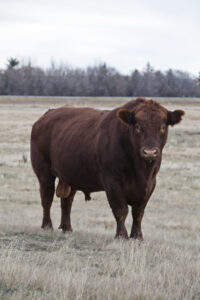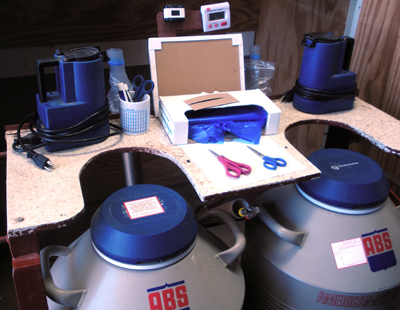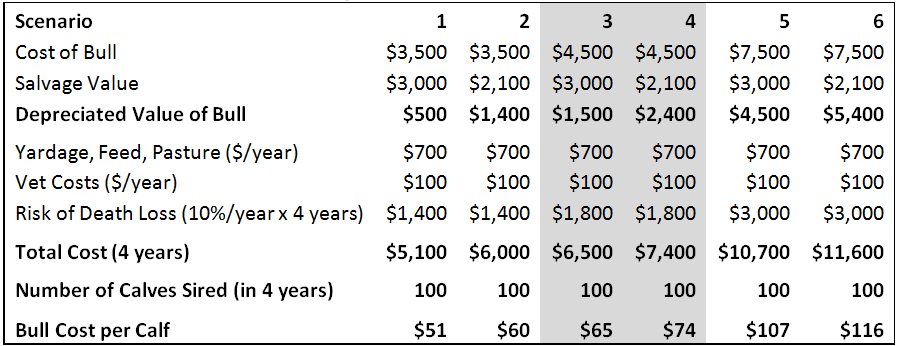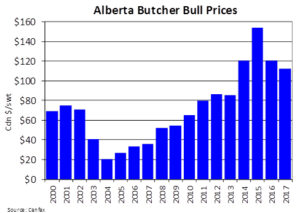Costs of Siring Calves: Artificial Insemination Compared to Natural Service

As the breeding season approaches, some producers will consider using artificial insemination (AI) and estrous synchronization in their breeding herd; others will not because of the extra time, labour and management required in an AI program, the perceived costs of implementing AI, or they are unaware of the potential advantages of AI.
In this article, we will review economic analysis that compares the costs and benefits of fixed-time AI and natural service. Next, we will discuss how recent changes in breeding bull and butcher bull prices affect the cost of breeding programs. We will also look at a recent study that addresses the question of how many clean-up bulls are needed in a fixed-time AI program.
Economic Benefits and Hurdles of Using Fixed-Time AI
Compared to natural service, an obvious potential advantage of fixed time AI is to have more calves born in the first 21 days of the calving season, which allows producers to market larger, more uniform groups of calves. Some studies have shown as much as a 10 to 17 day calf age advantage and 20 to 44 lbs more per calf at weaning as a result of estrous synchronization (Johnson and Chenoweth). Despite the extra costs of an AI program, fixed-time AI is estimated to have a net benefit of $11,110 for a 40-cow herd compared to natural service because of improved conception and wean rates, as well as heavier weaning weights (Lardner et al., 2015).
Early calving, as a result of AI, may also affect the productive longevity of the cows. A study by Mousel, E. M., et al. (2014) on 2,195 cattle showed that early-calving heifers remained in the herd 5.1 years on average, compared to only 3.9 years for heifers that calved after the first 21 days of the calving season. In another group of 16,549 cattle, heifers that calved in the first 21 days, second 21 days, and later had an average longevity of 8.2, 7.6, and 7.2 years in the herd, respectively.
With increased longevity, early-calving heifers can produce at least one more calf in their lifetime, compared to late-calving heifers. The net return of an early-calving cow with 6 calves is estimated to be 8% (or $132/cow) higher than a late-calving cow that delivers a total of 5 calves during her lifespan (using the 10-year average calf price of $1.80/cwt, a weaning weight of 550 lb, and annual maintenance costs of $730/cow, but excluding the potential increase in revenue due to heavier weaning weights).

Despite the benefits, only 18% of Western Canadian producers utilize artificial insemination and 11.3% use estrus synchronization, according to the 2014 Western Canadian Cow-calf survey. Low adoption rates may be due to several reasons. Compared to natural breeding, AI requires more intense knowledge and management as well as increased investment in labour, facilities, equipment, semen, estrous synchronization drugs and animal handling.
Common hurdles to adopting AI are limited time, labour and availability of land. Cattle need to be near handling facilities for AI, which is a significant hurdle for producers with multiple breeding pastures spread out over a large area.
There is also uncertainty around the quality of semen purchased. There is a wide range in price, with no guarantee that higher-priced semen comes from high-quality animals. It is recommended that semen be examined before use or purchased from a reputable source and properly handled (including storage and thawing).
Table 1. Pros and Cons of AI and Natural Service
| Artificial Insemination | Natural Service | ||
|---|---|---|---|
| Cons | Pros | Cons | Pros |
| Greater equipment investment | Greater calf crop uniformity | Typically a longer calving season | Less labour |
| Estrous synchronization drugs | Greater reproductive longevity | Takes longer to introduce new genetics | Less risky than AI |
| Requires both semen and clean-up bulls | Higher weaning weights | ||
| More labour and management | Shorter calving season |
Bull Cost and Salvage Value
Looking at bull prices at selected February bull sales in Alberta and Saskatchewan during 2015-2018, prices have moderated from the 2015-2016 peak of $5,500-$8,000/bull to $4,500-$6,500/bull in 2017-2018.
While the downtrend in breeding bull prices reduces the cost of natural breeding programs, some of the savings could be lost if butcher bull value moves lower at the end of the bull’s useful life.
In 2017, Alberta butcher bull prices averaged $112/cwt, down 7% from 2016 and down 27% from the peak seen in 2015. For a 2,000 lb bull, the salvage value in 2017 is estimated at $2,240/head, compared to $2,410/head in 2016 and $3,072 in 2015. For a bull purchased at $4,500, a 7% decline in the salvage value from $2,100 to $1,700 means the depreciation costs increased from $2,400 to $2,800.
Using the BCRC’s Costs of Natural Breeding calculator, Table 2 below shows the estimated cost per calf with three purchase prices of bulls ($3,500; $4,500; and $7,500) and two salvage values ($3,000 and $2,100). Bull purchase price is a significant cost factor in a natural breeding program as the percentage change in purchase price causes a similar percentage change in the average bull cost per calf, when other costs are steady.
For example, when bull prices drop 22% from $4,500 to $3,500, average cost per calf also drops by about 22%. On the other hand, a 30% decline in salvage value from $3,000 to $2,100 could result in an 8-18% increase in bull cost per calf, depending on the purchase price scenario. While the estimated impact of salvage value appears to be relatively small, producers should keep in mind the potential of a further price decline at the end of the bull’s useful life. If butcher bull prices drop from $100/cwt to the 2012-2013 level of $85/cwt, the average cost per calf could increase by another 3-7%.
Table 2. Costs of Natural Breeding

Depending on the protocol employed, fixed-timed AI, semen, additional labour/infrastructure, and clean-up bulls have been estimated to cost $10-20 more per bred female than natural service. Although fixed-time AI could have a higher cost per bred female than natural breeding, keep overall goals in mind, and compare the benefits of AI (cow longevity, faster genetic improvement and heavier weaning weights) against the higher costs to determine the best options for your operation.
Clean-up Bulls
The recent decline in breeding bull prices appears to favor the use of natural breeding over AI, but it should be remembered that bull prices can also affect the cost of an AI program due to the use of clean-up bulls. As clean-up bulls are expected to breed 40-50% of females in a short period of time, they need to be physically fit and ideally their genetic makeup should be comparable to the AI sires. Lardner et al. (2015) estimated that the cost of clean-up bulls at $42/cow (based on the assumption of a 50% conception with AI) accounted for about 30% of the total cost of fixed-time artificial insemination at $130/cow.
A concern regarding clean-up bulls is that more bulls are needed to cover the synchronized females that did not become pregnant from AI because these females will return to estrus around the same time as each other; if the same bull-female ratio is needed in an AI program as natural breeding, the estimated cost of AI would increase significantly. But is this concern valid? How many clean-up bulls are needed after estrus synchronization and AI?
A recent study by Nielson and Funston (2016) provides a preliminary answer to this question. The study summarized data from published studies reporting AI and final pregnancy rates, and bull to female ratio, and found that final pregnancy rates following estrus synchronization and AI were similar for different bull to female ratios (Table 3). One clean-up bull per 20 females had similar results as one bull per 60 females. Bull age is an important factor to consider as experienced bulls are more efficient breeders.
Table 3. Final Pregnancy Rate of Varying Bull to Female Ratio
| Clean-up Bull to Estrus Synchronized Female Ratio | Average Final Pregnancy Rate (%) |
|---|---|
| 1 bull to 20-30 females | 87.8 |
| 1 bull to 31-49 females | 82.6 |
| 1 bull to 50-60 females | 89.2 |
While Nielson and Funston’s study provides evidence that fewer bulls are needed in an AI program compared to natural service, there is a lot of variation in terms of the optimum clean-up bull to female ratio depending on the efficiency of the bull, pasture size and terrain, the length of the breeding season and so on. For example, operations with larger, more rugged pastures may demand more clean-up bulls.
Learn More:
- Artificial Insemination (BCRC webpage)
- AI Cowculator (North Florida Research and Education Center app)
- Bull vs AI Breeding Costs (Kansas State University calculator)
- How Many Natural Service Sires are Needed After Estrous Synchronization? (Drovers, May 2017 article)
- The 30 day game changer: Improving Reproductive Efficiency and Profitability of Beef Herds (Dr. Cliff Lamb article)
- Economic Comparisons of Artificial Insemination vs. Natural Mating for Beef Cattle Herds (Mississippi State University publication)
- Applied Reproductive Strategies in Beef Cattle: AI Cost vs Return (Angus Journal article, February 2015)
Click here to subscribe to the BCRC Blog and receive email notifications when new content is posted.
The sharing or reprinting of BCRC Blog articles is welcome and encouraged. Please provide acknowledgement to the Beef Cattle Research Council, list the website address, www.BeefResearch.ca, and let us know you chose to share the article by emailing us at info@beefresearch.ca.
We welcome your questions, comments and suggestions. Contact us directly or generate public discussion by posting your thoughts below.
